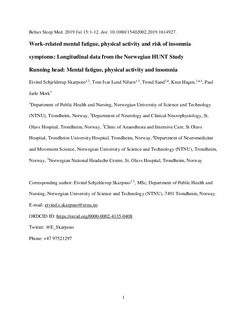| dc.contributor.author | Skarpsno, Eivind S. | |
| dc.contributor.author | Nilsen, Tom Ivar Lund | |
| dc.contributor.author | Sand, Trond | |
| dc.contributor.author | Hagen, Knut | |
| dc.contributor.author | Mork, Paul Jarle | |
| dc.date.accessioned | 2020-01-14T10:13:48Z | |
| dc.date.available | 2020-01-14T10:13:48Z | |
| dc.date.created | 2019-07-26T12:38:09Z | |
| dc.date.issued | 2019 | |
| dc.identifier.citation | Behavioural Sleep Medicine. 2019, 1-12. | nb_NO |
| dc.identifier.issn | 1540-2002 | |
| dc.identifier.uri | http://hdl.handle.net/11250/2636150 | |
| dc.description.abstract | Objective/Background: To examine the prospective association between work-related mental fatigue and risk of insomnia symptoms, and if leisure time physical activity modifies this association.
Participants: A total of 8,464 women and 7,480 men who participated in two consecutive surveys of the Norwegian HUNT study.
Methods: The study comprises longitudinal data on persons who were vocationally active and without insomnia symptoms at baseline in 1995–1997. We used a modified Poisson regression model to calculate adjusted risk ratios (RRs) with a 95% confidence interval (CI) for insomnia symptoms at follow-up in 2006–2008 associated with work-related mental fatigue and leisure time physical activity at baseline.
Results: Women and men who always experienced mental fatigue after a workday had RRs of insomnia symptoms of 2.55 (95% CI 1.91–3.40) and 2.61 (95% CI 1.80–3.78), respectively, compared to workers who never or seldom had this experience. There was no strong modifying effect of leisure time physical activity on this association, but workers who always experienced mental fatigue had a RR of insomnia symptoms of 3.17 (95% CI 2.28–4.40) if they reported low physical activity and a RR of 2.52 (95% 1.89–3.39) if they reported high physical activity.
Conclusion: This study shows that work-related mental fatigue, caused by high cognitive workload, is a strong risk factor for insomnia symptoms. There was no clear modifying effect of leisure time physical activity but workers who experienced excessive work-related fatigue accompanied by low physical activity had the highest risk of insomnia symptoms. | nb_NO |
| dc.language.iso | eng | nb_NO |
| dc.publisher | Taylor & Francis | nb_NO |
| dc.title | Work-Related Mental Fatigue, Physical Activity and Risk of Insomnia Symptoms: Longitudinal Data from the Norwegian HUNT Study | nb_NO |
| dc.type | Journal article | nb_NO |
| dc.type | Peer reviewed | nb_NO |
| dc.description.version | acceptedVersion | nb_NO |
| dc.source.pagenumber | 1-12 | nb_NO |
| dc.source.journal | Behavioural Sleep Medicine | nb_NO |
| dc.identifier.doi | 10.1080/15402002.2019.1614927 | |
| dc.identifier.cristin | 1712884 | |
| dc.description.localcode | Locked until 15.7.2020 due to copyright restrictions. This is an [Accepted Manuscript] of an article published by Taylor & Francis, available at https://doi.org/10.1080/15402002.2019.1614927 | nb_NO |
| cristin.unitcode | 1920,16,0,0 | |
| cristin.unitcode | 194,65,20,0 | |
| cristin.unitcode | 1920,28,0,0 | |
| cristin.unitcode | 194,65,30,0 | |
| cristin.unitcode | 1920,16,1,0 | |
| cristin.unitname | Nevroklinikken | |
| cristin.unitname | Institutt for samfunnsmedisin og sykepleie | |
| cristin.unitname | Klinikk for anestesi og intensivmedisin | |
| cristin.unitname | Institutt for nevromedisin og bevegelsesvitenskap | |
| cristin.unitname | Nasjonal kompetansetjeneste for hodepine | |
| cristin.ispublished | true | |
| cristin.fulltext | postprint | |
| cristin.qualitycode | 1 | |
